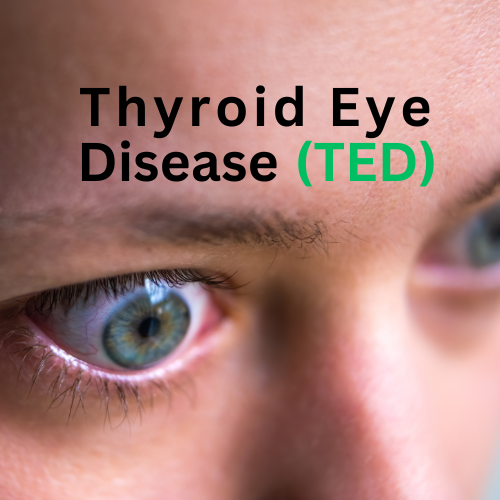Thyroid Eye Disease


About 90% of the cases of thyroid eye disease are in people who have Graves’ disease—an autoimmune disorder.
In this particular autoimmune disease that means that the body’s immune cells attack the thyroid gland, and the thyroid gland responds by secreting an excess amount of thyroid hormone.
The eyes are affected because tissues within the eye socket contain proteins that are like the proteins within the thyroid gland. However, about 1 in 10 people with TED develop it without having Graves’ disease. That is because the thyroid-stimulating hormone is also found in other tissues in the body, especially those around the eyes.
When the immune system attacks the muscles and other tissues in the eye socket, it causes swelling and scarring. It also causes the eyes to bulge forward and the eyelid to retract. Many patients with mild to moderate thyroid eye disease will experience spontaneous improvement in their condition within two to three years.
Thyroid eye disease (TED) can sometimes be difficult to diagnose, and patients may be treated for other conditions such as conjunctivitis, allergy or hay fever before the diagnosis of TED is made. Some signs that you have TED and not hay fever, allergies, or conjunctivitis:
- Symptoms of hay fever are occurring in the wrong season.
- Allergies usually cause itchy eyes, but TED does not.
- Conjunctivitis usually causes sticky eyes, but TED does not.
- TED sometimes causes double vision, but the other conditions do not.
- TED is often associated with an ache or pain in or behind the eye, especially when trying to look up or sideways, the other eye conditions mentioned do not cause eye pain when moving the eyes.
Symptoms of TED
- Bulging of the eyes
- A feeling of grittiness in the eyes or excessive dryness in the eyes
- Watery eyes
- Intolerance of bright lights
- Swelling or feeling of fullness in upper or lower eyelids
- New bags under the eyes
- Redness of the lids and eyes
Treatments
One treatment for Graves’ disease is radioactive iodine. This treatment can make active thyroid eye disease worse unless your provider also gives you steroids along with the iodine.
Anti-inflammatory drugs such as prednisone and other steroids may be prescribed. The FDA approved a drug called Tepezza in 2020 and it improves the signs and symptoms of TED including eye pain, redness, and swelling.
Tepezza is an intravenous (IV) infusion that is given every 3 weeks for about 5 months. The infusions are typically given in a clinic or your doctor’s office.
Surgery for TED
There are eyelid and eye muscle surgeries and a type of surgery to relieve the pressure of the optic nerve by making the eye socket larger, which will also lessen eye bulging.
Eye muscle surgery can correct the double vision that often accompanies TED and can reposition the eyes into a more normal position and help relieve dry eyes by ensuring the eyelids can completely close.
Make an appointment
If you notice blurry vision, dry or watery eyes or eyes that have a gritting feeling, make an appointment for an eye exam. Diagnosing and treating thyroid eye disease early can help you avoid some of the damage it can cause.
It is also very important to stop smoking, if you do smoke.
The outlook for people with TED is good. Thyroid eye disease in its active phase can last between one and three years. But if it is left untreated during that time, the inflammation from the disease may cause damage to your vision.
Gregory Scimeca, M.D.
Ophthalmologist and Medical Director
The Eye Professionals
Our Locations
